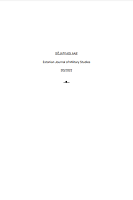FOREST CLASSES COMMON IN ESTONIA REFLECTING MILITARY ASPECTS OF A TERRAIN BASED ON THE SIZE OF TREE STEMS AND FOREST DENSITY
FOREST CLASSES COMMON IN ESTONIA REFLECTING MILITARY ASPECTS OF A TERRAIN BASED ON THE SIZE OF TREE STEMS AND FOREST DENSITY
Author(s): Kersti Vennik, Kaarel Piip, Mait LangSubject(s): Environmental Geography, Security and defense, Military policy
Published by: Kaitseväe Akadeemia (KVA)
Keywords: fields of fire; mobility; cover; concealment; OCOKA; tree stem diameter; space between the trees; tree location pattern; forest stand;
Summary/Abstract: Military aspects of a terrain include obstacles, observation or fields of fire, cover and concealment, key terrain, and avenues of approach (OCOKA). These are used for evaluating the conditions of a terrain for battling1 . Wooded areas are not typical grounds for fighting. Due to longer fields of fire and better mobility, many powerful armies prefer open areas. However, there are always certain reasons to operate in wooded areas. Some of the important forest characteristics for fighting are tree stem diameter and the space between trees. Both characteristics are mainly dependent on the age of a forest but also on forest stand history. In this paper, we examine the formation of the structural parameters of forests in Estonia. We will identify basic forest classes based on the Estonian forest inventory database, and discuss their influence on OCOKA.
Journal: Sõjateadlane
- Issue Year: 2023
- Issue No: 21
- Page Range: 103-119
- Page Count: 17
- Language: English

